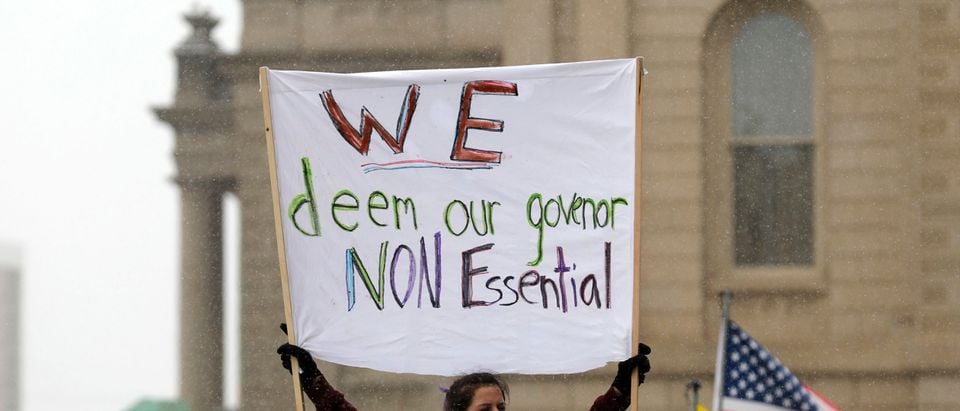Democrat controlled states have higher rates of unemployment, according to the July data from the Bureau of Labor Statistics (BLS).
The United States’ unemployment rate for July was 10.2%, according to the BLS. However, five states with the highest levels of unemployment are well above the national average, per the BLS:
- Massachusetts (16.1%)
- New York (15.9%)
- Nevada (14.0%)
- New Jersey (13.8%)
- Pennsylvania (13.7%)
The top five states are also majority Democrat-run:
- Massachusetts has a majority Democrat state legislature, Republican Gov. Charlie Baker, and Democratic U.S Sen. Ed Markey and Sen. Elizabeth Warren
- New York has a majority Democrat state legislature, Democratic Gov. Andrew Cuomo, and Democratic U.S Sen. Chuck Schumer and Sen. Kirsten Gillibrand
- Nevada has a majority Democrat state legislature, Democratic Gov. Steve Sisolak, and Democratic U.S Sen. Catherine Cortez Masto and Sen. Jacky Rosen
- New Jersey has a majority Democrat state legislature, Democratic Gov. Phil Murphy, and Democratic U.S Sen. Cory Booker and Sen. Bob Menendez
- Pennsylvania has a majority Republican state legislature, Democratic Gov. Tom Wolf, and Democratic U.S Sen. Bob Casey Jr. and Republican Sen. Pat Toomey
Meanwhile, Republican controlled states like Georgia had a July unemployment rate of 7.6%, while Republican controlled Florida saw an 11.3% unemployment rate in July.
Aside from the five states with high levels of unemployment, data shows that Democratic trifecta states, where Democrats control both state legislatures and the governorship, have a higher level of unemployment than their Republican counterparts. There are currently fifteen Democratic trifectas and 21 Republican trifectas.
Democratic trifecta states are:
- California (13.3)
- Colorado (7.4)
- Connecticut (10.2)
- Delaware (10.4)
- Hawaii (13.1)
- Illinois (11.3)
- Maine (9.9)
- Nevada (14)
- New Jersey (13.8)
- New Mexico (12.7)
- New York (15.9)
- Oregon (10.4)
- Rhode Island (11.2)
- Virginia (8)
- Washington (10.3)
- Washington, D.C (8.4)
According to the data, Democrat Trifectas have an average unemployment rate of 11.3% compared to Republican trifectas which have an average unemployment rate of 7.7%. In states that lean Democrat, where Democrats control 2 out of 3 of either the state senate, state house or governorship, the average unemployment rate is 9.6%, compared to states that lean Republican which shows an average unemployment rate of 8.9%. (RELATED: WSJ: Democratically Run States With The Most Severe Lockdowns Are Struggling To Recover)

July state unemployment trifectas, per BLS data (Dr. Erwin Antoni)
The data comes as the country grapples with the economic fallout stemming from lockdown measures put in place to curb the spread of the pandemic.
In New York, Cuomo imposed a lockdown of nonessential businesses in March. But some researchers say a more targeted approach in New York and other states might have protected public health while also causing less economic pain, according to The New York Times (NYT).
“The blunt instrument of a uniform policy causes more economic and related health harm than is necessary to accomplish the same goal of not increasing infections,” said John Birge, a mathematician at the University of Chicago who authored the study, per the NYT.
Meanwhile, economist Katherine Baicker at the University of Chicago who took part in the research said differentiating between essential and non-essential businesses could’ve been one of the reasons states that instituted broad lockdown measures were hurt.
“The distinction between essential and nonessential businesses is very arbitrary. In a world where policymakers could be nuanced across type of business, geography and time, the policy response could be much better,” she said, according to the NYT.
Data also shows the pandemic affected workers and companies in more Democratic states than in Republican states, according to The Economist.
Between January 15 and April 9, the number of weekly unemployment claims per 100 workers in Trump-supporting states increased from 1.1 to 12.7, whereas Clinton-supporting states saw numbers jump from 1.9 to 16.
A big reason for this data is that consumers in Trump country (which are areas that saw high voter support for Trump in the 2016 election, per The Economist) have been less constrained by lockdowns. Republican governors generally took action to address the pandemic later than their Democratic counterparts and imposed fewer restrictions, according to The Economist.












